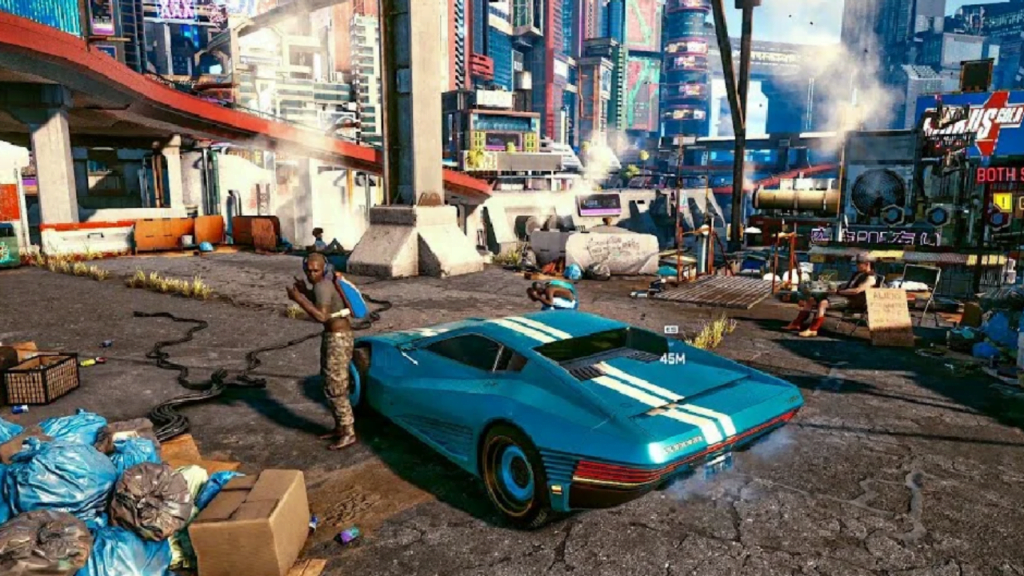The question is no longer, will it happen? The question now is when? For as much as I would like to say, maybe it will happen or it’s interesting to theorize, the truth is, other than the fancy cyberware, all other attributes of the world of Cyberpunk 2077 are already present throughout the world. Before I start to delve into why Cyberpunk 2077 is less fiction and more documentary of the future, I must steer your perception of the Cyberpunk world away from the perspective of Cyberpunk 2077’s characters and give you a more holistic idea of what such a society would be like.
The best way to establish such a holistic top-level (God’s Eye) view would be to encapsulate the common elements across all prominent stories of the genre into an identity of such a world which will then allow us to accurately compare our world against it and identify how far away are we from this future.
What is Cyberpunk?
According to the Oxford Dictionary, Cyberpunk is a genre of science fiction set in a lawless subculture of an oppressive society dominated by computer technology. Another definition is A science fiction genre focusing on a blurring of distinctions between humans and machines in bleak dystopias with lawless subcultures. Both statements together cover almost every aspect of the cyberpunk world.
To encapsulate it, a Cyberpunk future hints towards a dystopian future where technological feats such as curing all possible diseases, replacing any body parts with better cyberware, artificial intelligence, autonomous vehicles, flying cars, and all other such wonders have been achieved. However, only the ultra-rich members of society, such as executives and owners of mega-corporations have access to these wonders in technology and medicine. On the other hand, the rest of the world’s population is crammed into cities after excessive environmental deterioration thanks to the excessive use of fossil fuels, mining, deforestation, and culling of animals.

With the world’s population crammed into large cities, meager resources to go around, and those too being throttled by the megacorps whose top brass have totalitarian control of puppet-like governments, the socio-economic disparities rival oceanic proportions. Crime and disease are rampant as those not in the highest echelons of society are left fighting for scraps, like rats who cannibalize the pups when the food source runs dry, gangs form and exploit torment other poor civilians who live without associations to megacorps or gangs.
How Do We Compare?
In many ways, we are already living in this so-called dystopia, there are several points of comparison:
Economic Disparity
A major theme of the world in Cyberpunk 2077 is economic inequality, this is true in our world on a global and local scale. On a global scale, one could compare first-world and third-world countries, and how most people in developed countries enjoy access to health care, water, food, shelter, education, and technology. Meanwhile, most people in under-developed countries live as though these are medieval times, dying from malnourishment, easily treatable diseases, and violence.
On a local scale, just look at the large metropolitans of first-world countries, where people on the lower echelon of society struggle to make ends meet, and many succumb to high tax rates, and inflation, and resort to a life on the street. In this aspect of the Cyberpunk 2077 world, our world is nearly there.
AI and Automation
Ever since the pandemic, corporations have accelerated the development of technologies and are automating different stages of product development, such as AI chatbots replacing programmers, writers, and journalists, whereas robots are replacing factory workers, drivers, and even waiters. Automated capitalism is increasing exponentially, layoffs are a regular occurrence, employment is at its lowest, and housing is at its highest, so much so that large corporations have recently taken over as majority buyers of real estate so that they can squeeze out even more profit from the regular public.

The world depicted in Cyberpunk 2077 is alarmingly close to reality, where those excluded from corporate ranks often resort to joining gangs, preying on the vulnerable to meet their needs. Rather than conforming to a system designed to oppress and exploit the majority while benefiting only the elite, individuals with ambition and determination may resort to violence to achieve their goals. This mirrors V’s choice to become a mercenary after being ousted from Arasaka, opting against becoming a powerless pawn subject to corporate whims, and instead seizing control over their fate, albeit through unfair means.
We may not be used to seeing such behavior in our current reality, but we are not far off from when society will degrade into chaos as a frustrated youth will accept chaos as their savior.
Neoliberalism
The reason why, apart from the cyberware, all else in our world and the world of Cyberpunk 2077 seems so similar is the result of a societal system based on neoliberalism. Ronald Reagan and Margaret Thatcher were elected around 1980 in the US and UK respectively and both spearheaded the integration of neoliberalism in the Western world. To summarize neoliberalism in one line, it instructs to maximize economic growth through free market principles, whilst removing any governmental checks and balances on said market.
To explain neoliberalism’s principles further, it involves commoditizing all goods (marketization), transferring all goods and services to private ownership (Privatization), reducing oversight and friction towards economic growth (Deregulation or shrinking government), promoting international commerce and offshoring (Globalization), and undermining labor protections to enhance flexibility for employers (Flexible Labour Markets). So, all of these principles might look okay at first glance, something you’d do to boost the economy, however, these principles fail the common man and enrich the elite. With privatization and marketization, we will see things like the Trauma Team in Cyberpunk or the US healthcare system in our world.
With things like deregulation, corporations eventually grow far too large and powerful and then begin to have sway in the country’s litigation. Flexible labor markets allow corporations to undermine unions, treat their workers in any way they want, and fire them at will. So neoliberalism was integrated into Western society in the 1980s and ever since then elites at the helm of corporations have had an open season to indulge in power-seeking activities. This is the underlying reason why the world of cyberpunk feels similar to our own and why ours is undoubtedly heading in that direction. In the words of Mike Pondsmith, the creator of the Cyberpunk tabletop game and consultant to CDPR for Cyberpunk 2077:
“Cyberpunk was a warning, not an aspiration”
The chart shows {publication reference at the end} that since the implementation of neoliberalism in the Western world, and by extension most of the developed world, productivity has steadily increased. In contrast, wages have remained flat for the last 40 years.
Cyberware
This is the aspect in which our world is still years behind what we see in Cyberpunk 2077, that is, advanced cyberware and prosthetics, like the arm canon, sandevistan, cyberdeck, or mantis blades. I could give you some examples that would give the illusion that technology in our world has caught up to that seen in Cyberpunk 2077. Similar to the Braindance wreaths, there are Augmented Reality gadgets available, such as Oculus Quest and Google glasses.
Similar to the AIs like Delamain, we have AIs like ChatGPT and Bard with whom we can interact. However, our versions of those technologies leave much to be desired since our VR or AR devices do not allow you to “relive” someone’s memories, they instead offer a crude digitized version of our world; similarly, the AIs we have are not sentient or intelligent, they rely on machine learning models trained on massive amounts of internet data, basically its data science under the hood.

If we discuss cyberware specifically, which is technology that relies on a working interface between machines, computers, and the human nervous system, including the brain, our level of progress is nothing compared to what is depicted in Cyberpunk 2077. We do have the technology to create the hardware and the computers to control them.
Sure, we can make mantis blades and arm cannons that perfectly fit the size of a regular arm, however, we lack the capability of establishing an interface between the human brain and the technology. We do have a degree of prowess in this field since we have the artificial heart and robotic limbs, but even those don’t allow the sort of performance that their actual organic counterparts do in terms of receptiveness, efficiency, and synergy with the body.
The robotic prosthetics we currently have available are used by those who have lost those limbs due to illness or injury, people are not lining up to replace their flesh with these prosthetics because they are not nearly good enough since there is a lag between command and action and an acute lack of dexterity.
If Elon Musk’s company Neuralink, which is specifically working on developing implantable brain-computer interfaces, succeeds in its endeavors, then it would have essentially solved the problem that is halting the progress of cybernetics. Once this piece of the puzzle gets solved, it’s only a matter of time before we see cyberware rivaling the sophistication of that which we saw in Cyberpunk 2077, capable of not only meeting but exceeding the performance of organic counterparts.
Once the baseline technology is perfected, its use to create combat cyberware is inevitable. It all depends, however, on how soon the puzzle of efficient brain-computer interface is solved, which could be next week, a year, or a decade, by the looks of though, it could be a while before someone can fulfill their dream of surpassing Adam Smasher’s level of cybernetic enhancement.




